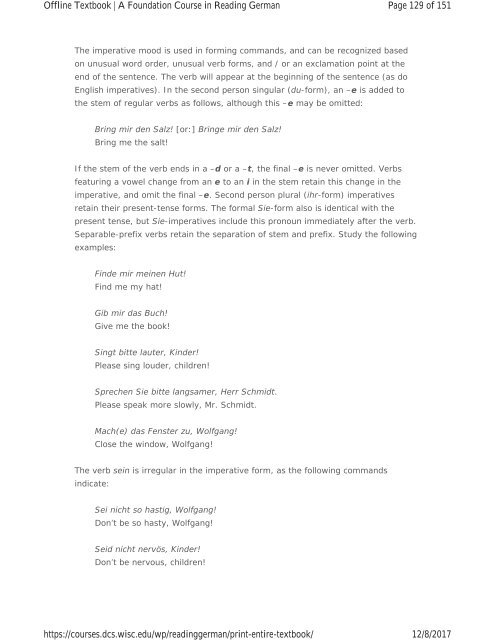A Foundation Course in Reading German, 2017a
A Foundation Course in Reading German, 2017a
A Foundation Course in Reading German, 2017a
Create successful ePaper yourself
Turn your PDF publications into a flip-book with our unique Google optimized e-Paper software.
Offl<strong>in</strong>e Textbook | A <strong>Foundation</strong> <strong>Course</strong> <strong>in</strong> Read<strong>in</strong>g <strong>German</strong><br />
https://courses.dcs.wisc.edu/wp/read<strong>in</strong>ggerman/pr<strong>in</strong>t-entire-textbook/<br />
Page 129 of 151<br />
12/8/2017<br />
The imperative mood is used <strong>in</strong> form<strong>in</strong>g commands, and can be recognized based<br />
on unusual word order, unusual verb forms, and / or an exclamation po<strong>in</strong>t at the<br />
end of the sentence. The verb will appear at the beg<strong>in</strong>n<strong>in</strong>g of the sentence (as do<br />
English imperatives). In the second person s<strong>in</strong>gular (du-form), an –e is added to<br />
the stem of regular verbs as follows, although this –e may be omitted:<br />
Br<strong>in</strong>g mir den Salz! [or:] Br<strong>in</strong>ge mir den Salz!<br />
Br<strong>in</strong>g me the salt!<br />
If the stem of the verb ends <strong>in</strong> a –d or a –t, the f<strong>in</strong>al –e is never omitted. Verbs<br />
featur<strong>in</strong>g a vowel change from an e to an i <strong>in</strong> the stem reta<strong>in</strong> this change <strong>in</strong> the<br />
imperative, and omit the f<strong>in</strong>al –e. Second person plural (ihr-form) imperatives<br />
reta<strong>in</strong> their present-tense forms. The formal Sie-form also is identical with the<br />
present tense, but Sie-imperatives <strong>in</strong>clude this pronoun immediately after the verb.<br />
Separable-prefix verbs reta<strong>in</strong> the separation of stem and prefix. Study the follow<strong>in</strong>g<br />
examples:<br />
F<strong>in</strong>de mir me<strong>in</strong>en Hut!<br />
F<strong>in</strong>d me my hat!<br />
Gib mir das Buch!<br />
Give me the book!<br />
S<strong>in</strong>gt bitte lauter, K<strong>in</strong>der!<br />
Please s<strong>in</strong>g louder, children!<br />
Sprechen Sie bitte langsamer, Herr Schmidt.<br />
Please speak more slowly, Mr. Schmidt.<br />
Mach(e) das Fenster zu, Wolfgang!<br />
Close the w<strong>in</strong>dow, Wolfgang!<br />
The verb se<strong>in</strong> is irregular <strong>in</strong> the imperative form, as the follow<strong>in</strong>g commands<br />
<strong>in</strong>dicate:<br />
Sei nicht so hastig, Wolfgang!<br />
Don’t be so hasty, Wolfgang!<br />
Seid nicht nervös, K<strong>in</strong>der!<br />
Don’t be nervous, children!


















